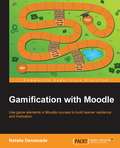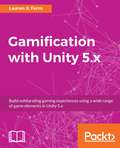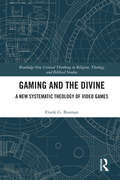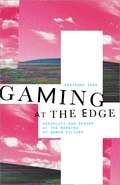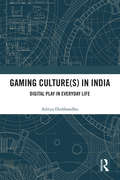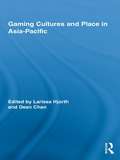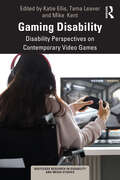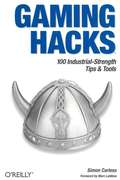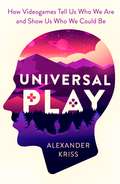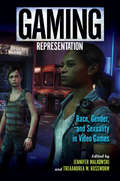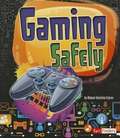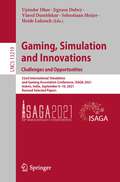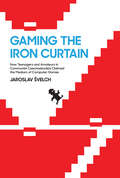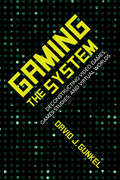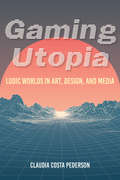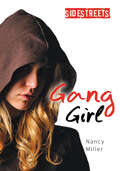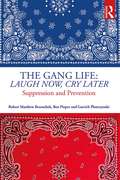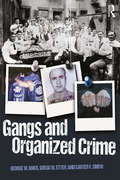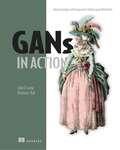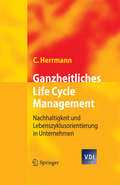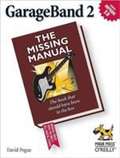- Table View
- List View
Gamification with Moodle
by Natalie DenmeadeUse game elements in Moodle courses to build learner resilience and motivationAbout This BookFormulate a Moodle course that acts as a flexible framework ready for your own contentKeep learners engrossed and create opportunities for motivation through the concepts of status, access, and powerA resourceful guide to innovative learning using automatic reports, assessments, and conditional release of activitiesWho This Book Is ForThis book has been designed for teachers who to use technology to create more engaging learning experiences for both online learning and in face-to-face sessions. This book will especially appeal to people who are interested in the underlying mechanics of play and games and want to know more about applying these concepts in an educational context. It is assumed that you are a teacher and expert in your field, have basic computer skills, and have access to the Internet.What You Will LearnSet up a scoring system using Moodle GradebookEnable communication and collaboration in your class as a Learning Community using forumsAssess your learners' abilities by setting up challenges and questsConfigure gateways to check and ensure progress before new content or activities are releasedCreate Moodle assignments to provide effective feedback through a comment bank and custom scaleIssue Open Badges to recognize achievements and set up an online backpack to share digital badgesReduce anxiety for learners by using the game-like concept of "Levelling Up"In DetailThis book describes how teachers can use Gamification design within the Moodle Learning Management System. Game elements can be included in course design by using, badges, rubrics, custom grading scales, forums, and conditional activities. Moodle courses do not have to be solo-learning experiences that replicate Distance Education models.The Gamification design process starts by profiling players and creating levels of achievement towards meeting learning outcomes. Each task is defined, valued, and sequenced. Motivation loops are devised to keep the momentum going. In a gaming studio, this approach would require a team of specialists with a large budget and time frames. Preparing for a class rarely has these optimal conditions. The approach used in this book is to introduce game elements into the course design gradually. First, apply gamification to just one lesson and then build up to gamifying a series of lessons over a term. Each example will indicate the difficulty level and time investment. Try it out to see what is most effective with your learners and choose wisely in your use of technology.By the end of the book, you will be able to create gripping Moodle courses for effective and efficient learning.Style and approachAn easy-to-follow guide full of screenshots and step-by-step instructions with estimated time frames required to accomplish numerous tasks. Tips are offered for new Moodlers and plugin extensions are suggested for advanced Moodlers. The focus of the book is on why you would want to use each activity rather than detailed technical descriptions.
Gamification with Unity 5.x
by Lauren S. FerroBuild exhilarating gaming experiences using a wide range of game elements in Unity 5.x About This Book * Achieve your goals in a fun-filled way by creating gamification projects from scratch * Leverage the Unity 5.X toolkit to create stunning and appealing projects * Make your transition towards a pro project manager/ developer by learning tricks and techniques Who This Book Is For If you are a project manager, game developer, or programmer who wants to create successful end-to-end gamification projects from scratch, then this is the book for you. You do not need any previous experience of working with Unity 5.X. All the details required to make the most of gamifying your projects are provided in the book. What You Will Learn * Assess your learners' abilities by setting up challenges and quests * Implement the game elements that relate to the project into Unity * Publish your own task management application to better engage readers * Improve your design using methods of playtesting and iteration * Issue OpenBadges to recognize achievements and set up an online database to store your users achievements. In Detail Are you looking at implementing gamification techniques for your business and wondering where to get a complete rundown of all the tricks and techniques? Well, you have come to the right place! This book will start right from the basics such as gameplay elements and their functionalities before gradually moving onto creating your first gamification project from scratch. You'll be given the tools and shown how to perform various techniques for creating gamified applications in different contexts. Finally, you will implement various game elements into Unity, publish your own task management application, and get to know the best practices and approaches when designing gamified experiences. Style and approach This book takes a real-world case studies approach, moving ahead in a step-by-step tutorial manner. You will create your own project from scratch, and the practical examples will help you create a successful gamification project.
Gaming and the Divine: A New Systematic Theology of Video Games (Routledge New Critical Thinking in Religion, Theology and Biblical Studies)
by Frank G. BosmanThis book formulates a new theological approach to the study of religion in gaming. Video games have become one of the most important cultural artifacts of modern society, both as mediators of cultural, social, and religious values and in terms of commercial success. This has led to a significant increase in the critical analysis of this relatively new medium, but theology as an academic discipline is noticeably behind the other humanities on this subject. The book first covers the fundamentals of cultural theology and video games. It then moves on to set out a Christian systematic theology of gaming, focusing on creational theology, Christology, anthropology, evil, moral theology, and thanatology. Each chapter introduces case studies from video games connected to the specific theme. In contrast to many studies which focus on online multiplayer games, the examples considered are largely single player games with distinct narratives and ‘end of game’ moments. The book concludes by synthesizing these themes into a new theology of video games. This study addresses a significant aspect of contemporary society that has yet to be discussed in any depth by theologians. It is, therefore, a fantastic resource for any scholar engaging with the religious aspects of digital and popular culture.
Gaming at the Edge: Sexuality and Gender at the Margins of Gamer Culture
by Adrienne ShawVideo games have long been seen as the exclusive territory of young, heterosexual white males. In a media landscape dominated by such gamers, players who do not fit this mold, including women, people of color, and LGBT people, are often brutalized in forums and in public channels in online play. Discussion of representation of such groups in games has frequently been limited and cursory. In contrast, Gaming at the Edge builds on feminist, queer, and postcolonial theories of identity and draws on qualitative audience research methods to make sense of how representation comes to matter. In Gaming at the Edge, Adrienne Shaw argues that video game players experience race, gender, and sexuality concurrently. She asks: How do players identify with characters? How do they separate identification and interactivity? What is the role of fantasy in representation? What is the importance of understanding market logic? In addressing these questions Shaw reveals how representation comes to matter to participants and offers a perceptive consideration of the high stakes in politics of representation debates. Putting forth a framework for talking about representation, difference, and diversity in an era in which user-generated content, individualized media consumption, and the blurring of producer/consumer roles has lessened the utility of traditional models of media representation analysis, Shaw finds new insight on the edge of media consumption with the invisible, marginalized gamers who are surprising in both their numbers and their influence in mainstream gamer culture.
Gaming Culture(s) in India: Digital Play in Everyday Life
by Aditya DeshbandhuThis volume critically analyzes the multiple lives of the "gamer" in India. It explores the "everyday" of the gaming life from the player’s perspective, not just to understand how the games are consumed but also to analyze how the gamer influences the products’ many (virtual) lives. Using an intensive ethnographic approach and in-depth interviews, this volume situates the practice of gaming under a broader umbrella of digital leisure activities and foregrounds the proliferation of gaming as a new media form and cultural artifact; critically questions the term gamer and the many debates surrounding the gamer tag to expand on how the gaming identity is constructed and expressed; details participants’ gaming habits, practices and contexts from a cultural perspective and analyzes the participants’ responses to emerging industry trends, reflections on playing practices and their relationships to friends, communities and networks in gaming spaces; and examines the offline and online spaces of gaming as sites of contestation between developers of games and the players. A holistic study covering one of the largest video game bases in the world, this volume will be of great interest to scholars and researchers of cultural studies, media and communication studies and science and technology studies, as well as be of great appeal to the general reader.
Gaming Cultures and Place in Asia-Pacific (Routledge Studies in New Media and Cyberculture)
by Larissa Hjorth Dean ChanThis collection explores the relationship between digital gaming and its cultural context by focusing on the burgeoning Asia-Pacific region. Encompassing key locations for global gaming production and consumption such as Japan, China, and South Korea, as well as increasingly significant sites including Australia and Singapore, the region provides a wealth of divergent examples of the role of gaming as a socio-cultural phenomenon. Drawing from micro ethnographic studies of specific games and gaming locales to macro political economy analyses of techno-nationalisms and trans-cultural flows, this collection provides an interdisciplinary model for thinking through the politics of gaming production, representation, and consumption in the region.
Gaming Disability: Disability Perspectives on Contemporary Video Games (Routledge Research in Disability and Media Studies)
by Katie Ellis Tama Leaver Mike KentThis book explores the opportunities and challenges people with disabilities experience in the context of digital games from the perspective of three related areas: representation, access and inclusion, and community. Drawing on key concerns in disability media studies, the book brings together scholars from disability studies and game studies, alongside game developers, educators, and disability rights activists, to reflect upon the increasing visibility of disabled characters in digital games. Chapters explore the contemporary gaming environment as it relates to disability on platforms such as Twitch, Minecraft, and Tingyou, while also addressing future possibilities and pitfalls for people with disabilities within gaming given the rise of virtual reality applications, and augmented games such as Pokémon Go. The book asks how game developers can attempt to represent diverse abilities, taking games such as BlindSide and Overwatch as examples. A significant collection for scholars and students interested in the critical analysis of digital games, this volume will be of interest across several disciplines including game studies, game design and development, internet, visual, cultural, communication and media studies, as well as disability studies.
Gaming Hacks
by Simon CarlessIt doesn't take long for an avid or just wickedly clever gamer to be chafed by the limitations of videogame software or hardware. If you want to go far beyond the obvious, there's an awful lot of free fun you can have, using the creative exploits of the gaming gurus. Gaming Hacks is the indispensable guide to cool things gamers can do to create, modify, and hack videogame hardware and software.
The Gaming Mind: A New Psychology of Videogames and the Power of Play
by Alexander KrissEven as the popularity of videogames has skyrocketed, a dark cloud continues to hang over them. Many people who play games feel embarrassed to admit as much, and many who don't worry about the long-term effects of a medium often portrayed as dangerous and corruptive.Drawing on years of experience working directly with people who play games, clinical psychologist Alexander Kriss steers the discourse away from extreme and factually inaccurate claims around the role of games in addiction, violence and mental illness, instead focusing on the importance of understanding the unique relationship that forms between a game and its player.Through vivid psychotherapy case illustrations, autobiographical memoir, and a wide range of psychological theory and research, The Gaming Mind lays out an honest and humanistic vision of games, their potentials and risks, and how they can teach us more about who we are and who we could be.
Gaming Representation: Race, Gender, and Sexuality in Video Games
by Jennifer Malkowski Treaandrea M. RusswormRecent years have seen an increase in public attention to identity and representation in video games, including journalists and bloggers holding the digital game industry accountable for the discrimination routinely endured by female gamers, queer gamers, and gamers of color. Video game developers are responding to these critiques, but scholarly discussion of representation in games has lagged far behind. Gaming Representation examines portrayals of race, gender, and sexuality in a range of games, from casuals like Diner Dash, to indies like Journey and The Binding of Isaac, to mainstream games from the Grand Theft Auto, BioShock, Spec Ops, The Last of Us, and Max Payne franchises. Arguing that representation and identity function as systems in games that share a stronger connection to code and platforms than it may first appear, the contributors to this volume push gaming scholarship to new levels of inquiry, theorizing, and imagination.
Gaming Safely
by Allyson Valentine Schrier Frank W. BakerIf a strange character offers you a gift in an online game, do you know what to do? Don't worry if you don't. This book is here to help! Learn tech-savvy ways to keep your game sites safe sites without taking away all the fun!
Gaming, Simulation and Innovations: 52nd International Simulation and Gaming Association Conference, ISAGA 2021, Indore, India, September 6–10, 2021, Revised Selected Papers (Lecture Notes in Computer Science #13219)
by Upinder Dhar Jigyasu Dubey Vinod Dumblekar Sebastiaan Meijer Heide LukoschThis book constitutes the refereed proceedings of the 52nd International Simulation and Gaming Association Conference, ISAGA 2021, held in Indore, India, during September 6–10, 2021. The 24 full papers included in this book were carefully reviewed and selected from 58 submissions. They were organized in topical sections as follows: game design and facilitation; gaming in education; player experience in simulations; and policy formulation and serious games.
Gaming the Iron Curtain: How Teenagers and Amateurs in Communist Czechoslovakia Claimed the Medium of Computer Games (Game Histories)
by Jaroslav SvelchHow amateur programmers in 1980s Czechoslovakia discovered games as a medium, using them not only for entertainment but also as a means of self-expression.Aside from the exceptional history of Tetris, very little is known about gaming culture behind the Iron Curtain. But despite the scarcity of home computers and the absence of hardware and software markets, Czechoslovakia hosted a remarkably active DIY microcomputer scene in the 1980s, producing more than two hundred games that were by turns creative, inventive, and politically subversive. In Gaming the Iron Curtain, Jaroslav Švelch offers the first social history of gaming and game design in 1980s Czechoslovakia, and the first book-length treatment of computer gaming in any country of the Soviet bloc. Švelch describes how amateur programmers in 1980s Czechoslovakia discovered games as a medium, using them not only for entertainment but also as a means of self-expression. Sheltered in state-supported computer clubs, local programmers fashioned games into a medium of expression that, unlike television or the press, was neither regulated nor censored. In the final years of Communist rule, Czechoslovak programmers were among the first in the world to make activist games about current political events, anticipating trends observed decades later in independent or experimental titles. Drawing from extensive interviews as well as political, economic, and social history, Gaming the Iron Curtain tells a compelling tale of gaming the system, introducing us to individuals who used their ingenuity to be active, be creative, and be heard.
Gaming the System: Deconstructing Video Games, Games Studies, and Virtual Worlds (Digital Game Studies)
by David J. GunkelGaming the System takes philosophical traditions out of the ivory tower and into the virtual worlds of video games. In this book, author David J. Gunkel explores how philosophical traditions—put forth by noted thinkers such as Plato, Descartes, Kant, Heidegger, and Žižek—can help us explore and conceptualize recent developments in video games, game studies, and virtual worlds. Furthermore, Gunkel interprets computer games as doing philosophy, arguing that the game world is a medium that provides opportunities to model and explore fundamental questions about the nature of reality, personal identity, social organization, and moral conduct. By using games to investigate and innovate in the area of philosophical thinking, Gunkel shows how areas such as game governance and manufacturers’ terms of service agreements actually grapple with the social contract and produce new postmodern forms of social organization that challenge existing modernist notions of politics and the nation state. In this critically engaging study, Gunkel considers virtual worlds and video games as more than just "fun and games," presenting them as sites for new and original thinking about some of the deepest questions concerning the human experience.
Gaming Utopia: Ludic Worlds in Art, Design, and Media
by Claudia Costa PedersonIn Gaming Utopia: Ludic Worlds in Art, Design, and Media, Claudia Costa Pederson analyzes modernist avant-garde and contemporary video games to challenge the idea that gaming is an exclusively white, heterosexual, male, corporatized leisure activity and reenvisions it as a catalyst for social change. By looking at over fifty projects that together span a century and the world, Pederson explores the capacity for sociopolitical commentary in virtual and digital realms and highlights contributions to the history of gaming by women, queer, and transnational artists. The result is a critical tool for understanding video games as imaginative forms of living that offer alternatives to our current reality. With an interdisciplinary approach, Gaming Utopia emphasizes how game design, creation, and play can become political forms of social protest and examines the ways that games as art open doors to a more just and peaceful world.
Gang Girl (Lorimer SideStreets)
by Nancy MillerWhen Sasha moves from Russia with her mother, she's eager to start a new life. At her new school she joins CREW (Confident, Remarkable, Excellent, Welcoming), a girls' volunteer group. But she quickly learns that the group is a front for a girl gang and their true philosophy is to Con, Rip Off, Exploit, and Weaken the people they claim to help. Their leader is eager to exploit Sasha's computer skills for a more lucrative level of crime: stealing identities and blackmailing men online. This story plays out against the backdrop of peer pressure and digital media, showing readers that fitting in with a group isn't worth sacrificing your safety and integrity. Distributed in the U.S by Lerner Publishing Group
The Gang Life: Suppression and Prevention
by Robert Matthew Brzenchek Ben Pieper Garrick PlonczynskiThe Gang Life: Laugh Now, Cry Later examines the criminal gangster mindset and offers gang prevention strategies, using real-world examples to demonstrate a holistic approach toward combatting this surging societal problem. The text outlines the evolution of gang membership from a state of interest, to association, to hardcore "O.G." (Original Gangster) status, and explores the evolution of law enforcement’s multi-pronged approach to combating criminal street gang violence, from the catch-and-release mentality of the 1970s and 1980s to today’s collaboration with private organizations such as Boys & Girls Clubs. In-depth profiles, case studies, and lengthy histories of gangs, gang members, and their transformations are provided to demonstrate the deleterious effect of gangs on society. Designed for criminal justice students and for practitioners in the field, this text offers readers a holistic approach toward gang prevention from three nationally awarded educators and gang investigators.
Gangs and Organized Crime
by George W. Knox Gregg Etter Carter F. SmithIn <i>Gangs and Organized Crime</i>, George W. Knox, Gregg W. Etter, and Carter F. Smith offer an informed and carefully investigated examination of gangs and organized crime groups, covering street gangs, prison gangs, outlaw motorcycle gangs, and organized crime groups from every continent. The authors have spent decades investigating gangs as well as researching their history and activities, and this dual professional-academic perspective informs their analysis of gangs and crime groups. They take a multi-disciplinary approach that combines criminal justice, public policy and administration, law, organizational behavior, sociology, psychology, and urban planning perspectives to provide insight into the actions and interactions of a variety of groups and their members. This textbook is ideal for criminal justice and sociology courses on gangs as well as related course topics like gang behavior, gang crime and the inner city, organized crime families, and transnational criminal groups. <i>Gangs and Organized Crime</i> is also an excellent addition to the professional’s reference library or primer for the general reader.
GANs for Data Augmentation in Healthcare
by Arun Solanki Mohd NavedComputer-Assisted Diagnostics (CAD) using Convolutional Neural Network (CNN) model has become an important technology in the medical industry, improving the accuracy of diagnostics. However, the lack Magnetic Resonance Imaging (MRI) data leads to the failure of the depth study algorithm. Medical records often different because of the cost of obtaining information and the time-consuming information. In general, clinical data are unreliable, the training of neural network methods to distribute disease across classes does not yield the desired results. Data augmentation is often done by training data to solve problems caused by augmentation tasks such as scaling, cropping, flipping, padding, rotation, translation, affine transformation, and color augmentation techniques such as brightness, contrast, saturation, and hue.Data Augmentation and Segmentation imaging using GAN can be used to provide clear images of brain, liver, chest, abdomen, and liver on MRI. In addition, GAN shows strong promise in the field of clinical image synthesis. In many cases, clinical evaluation is limited by a lack of data and/or the cost of actual information. GAN can overcome these problems by enabling scientists and clinicians to work on beautiful and realistic images. This can improve diagnosis, prognosis, and disease. Finally, GAN highlights the potential for location of patient information with data. This is a beneficial clinical application of GAN because it can effectively protect patient confidentiality. This book covers the application of GANs on medical imaging augmentation and segmentation.
GANs in Action: Deep learning with Generative Adversarial Networks
by Vladimir Bok Jakub LangrDeep learning systems have gotten really great at identifying patterns in text, images, and video. But applications that create realistic images, natural sentences and paragraphs, or native-quality translations have proven elusive. Generative Adversarial Networks, or GANs, offer a promising solution to these challenges by pairing two competing neural networks' one that generates content and the other that rejects samples that are of poor quality. GANs in Action: Deep learning with Generative Adversarial Networks teaches you how to build and train your own generative adversarial networks. First, you'll get an introduction to generative modelling and how GANs work, along with an overview of their potential uses. Then, you'll start building your own simple adversarial system, as you explore the foundation of GAN architecture: the generator and discriminator networks.Purchase of the print book includes a free eBook in PDF, Kindle, and ePub formats from Manning Publications.
Ganzheitliche Digitalisierung von Prozessen: Perspektivenwechsel - Design Thinking - Wertegeleitete Interaktion
by Matthes Elstermann Albert Fleischmann Christoph Moser Stefan Oppl Werner Schmidt Christian StaryIn dieser erweiterten und aktualisierten 2. Auflage des ursprünglichen Open-Access Buches wird das Geschäftsprozessmanagement als ein ganzheitlicher Prozess begriffen, der der Mitwirkung aller Stakeholder bedarf. Denn das traditionelle Business Process Engineering stößt heute angesichts der Digitalisierung und der dynamischen Entwicklung von Organisationen immer mehr an seine Grenzen, beispielsweise bezüglich Agilität. Um nun das Wesen von Aufgaben und Abläufen in Organisationen zu erfassen, schlagen die Autoren einen Perspektivenwechsel vor: das Denken in Kommunikationsprozessen. Dieses Konzept lässt sich wirtschaftlich, organisatorisch und technisch ohne einschlägige Vorkenntnisse umsetzen. Leserinnen und Leser finden in dem Buch konkrete Handlungsanleitungen für die Digitalisierung von organisationsrelevanten Abläufen. Daneben liefern die Autoren Einblicke in die Systemtheorie und in das Design Thinking. Ihr Ziel ist, Konzepte einfach und verständlich zu erläutern, ohne dabei komplexe Zusammenhänge zu vernachlässigen. Dank ausführlicher Konzeptdarstellung und Ausflüge in die Theorie mit Beispielen aus der Praxis, eignet es sich für Studierende und für Wissenschaftler genauso wie für Praktiker. Entwickler und andere Fachkräfte aus den Bereichen Operatives Management, Geschäftsprozessmanagement, Organisationsentwicklung, Qualitätsmanagement, Wissensmanagement werden sich von der Übersichtlichkeit und dem Nutzwert angesprochen fühlen.
Ganzheitliche Digitalisierung von Prozessen: Perspektivenwechsel - Design Thinking - Wertegeleitete Interaktion
by Christian Stary Werner Schmidt Stefan Oppl Albert FleischmannIn diesem Open-Access-Buch wird das Geschäftsprozessmanagement als ein ganzheitlicher Prozess begriffen, der der Mitwirkung aller Stakeholder bedarf. Denn das traditionelle Business Process Engineering stößt heute angesichts der Digitalisierung und der dynamischen Entwicklung von Organisationen immer mehr an seine Grenzen, beispielsweise bezüglich Agilität. Um nun das Wesen von Aufgaben und Abläufen in Organisationen zu erfassen, schlagen die Autoren einen Perspektivwechsel vor: das Denken in Kommunikationsprozessen. Dieses Konzept lässt sich wirtschaftlich, organisatorisch und technisch ohne einschlägige Vorkenntnisse umsetzen. Leserinnen und Leser finden in dem Buch konkrete Handlungsanleitungen für die Digitalisierung von organisationsrelevanten Abläufen. Daneben liefern die Autoren Einblicke in die Systemtheorie und in das Design Thinking. Ihr Ziel ist, Konzepte einfach und verständlich zu erläutern, ohne dabei komplexe Zusammenhänge zu vernachlässigen. Dank ausführlicher Konzeptdarstellung und Ausflüge in die Theorie mit Beispielen aus der Praxis, eignet es sich für Studierende und für Wissenschaftler genauso wie für Praktiker. Entwickler und andere Fachkräfte aus den Bereichen Operatives Management, Geschäftsprozessmanagement, Organisationsentwicklung, Qualitätsmanagement, Wissensmanagement werden sich von der Übersichtlichkeit und dem Nutzwert angesprochen fühlen.
Ganzheitliches Life Cycle Management
by Christoph HerrmannWenn Unternehmen die Anforderungen einer nachhaltigen Entwicklung umsetzen, stehen sie vor der zentralen Aufgabe, Produkte und Prozesse lebensphasenübergreifend zu betrachten. Der Autor stellt die Gestaltungsmöglichkeiten des Life Cycle Managements vor und unterscheidet zwischen lebensphasenbezogenen Disziplinen wie z. B. dem Produkt- und Produktions-Management sowie lebensphasenübergreifenden Disziplinen (z. B. Informations- und Wissensmanagement). Zahlreiche Anwendungsbeispiele und Abbildungen dienen der Veranschaulichung der Inhalte.
Garage Glamour
by Rolando GomezNude and beauty photographers can find the invaluable highimpact techniques in this exhaustively illustrated manual that covers everything from compositional tips for clothing, accessories, and poses to more technical challenges such as lighting, lens selection, and exposure, demonstrating how to produce stunning, worldclass images using minimal equipment without accruing a burdening investment. Beginning with the Four S's of glamour photography (sexiness, sultriness, sensuality, and seductiveness), amateurs and professionals alike are shown new ways to achieve beautiful shots, with additional tips on working with models that include methods for accentuating assets while minimizing flaws and initiating comfortable working relationships. Photographers are also shown how to turn their hobby into a successful career, or enhance the productivity and income of an existing business by honing marketing and advertising skills and mastering the art of generating business by referral. Based on the author's popular website (garageglamour.com), this guide offers helpful instruction to creating glamorous, sexy images like those seen in Playboy, Maxim, and other men's magazines.
GarageBand 2: The Missing Manual
by David PogueWhether you're a professional musician or a mere novice, Apple's GarageBand software has everything you need to produce commercial-quality recordings entirely on your own. Just imagine how many thousands of singers and instrumentalists remain undiscovered because they lack the capability to produce viable demos. Well, no more. Now there's no need to assemble a backup band or book time at a professional studio--GarageBand has it covered. And GarageBand 2: The Missing Manual gives you the know-how you need to make it all happen. It's an authoritative, witty guide to constructing digital recordings with GarageBand. Written by the master of the Missing Manual series, and a musician himself, David Pogue, this top-selling book shows you how to maximize the program's entire set of tools. Pre-recorded loops, sampled sounds, live recordings--they're all explained in easy-to-understand language. It also shows you how to apply professional-sounding effects like reverb or chorusing, and then export the finished product to iTunes, where you can download your work to an iPod, export it as an MP3, or burn it onto CDs. Now revised to reflect GarageBand's latest features, this book's second edition also addresses how to: use GarageBand's eight-track capabilities display music notation in real time enhance timing and pitch for better quality recordings change the tempo and key of recorded instruments tune guitars with GarageBand before recording So if you're chasing a dream or just having fun, GarageBand 2: The Missing Manual is the only resource you need to make the finest musical recordings possible.
